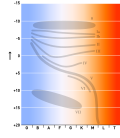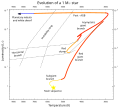The red-giant branch (RGB), sometimes called the first giant branch, is the portion of the giant branch before helium ignition occurs in the course of...
32 KB (3,932 words) - 10:31, 10 January 2025
most carbon stars. Red giants vary in the way by which they generate energy: most common red giants are stars on the red-giant branch (RGB) that are still...
28 KB (3,497 words) - 14:13, 4 April 2025
Tip of the red-giant branch (TRGB) is a primary distance indicator used in astronomy. It uses the luminosity of the brightest red-giant-branch stars in...
6 KB (645 words) - 10:29, 26 January 2025
late in their lives. Observationally, an asymptotic-giant-branch star will appear as a bright red giant with a luminosity ranging up to thousands of times...
26 KB (3,222 words) - 20:09, 15 March 2025
slightly hotter than most red-giant-branch stars of the same luminosity. It is visible as a denser region of the red-giant branch or a bulge towards hotter...
13 KB (1,733 words) - 15:54, 12 March 2025
dwarfs White dwarfs Red dwarfs Subdwarfs Main sequence ("dwarfs") Subgiants Giants Red giants Blue giants Bright giants Supergiants Red supergiant Hypergiants...
17 KB (2,383 words) - 19:06, 15 March 2025
Stellar evolution (section Red-giant-branch phase)
the red-giant branch. When hydrogen shell burning finishes, these stars move directly off the red-giant branch like a post-asymptotic-giant-branch (AGB)...
50 KB (6,439 words) - 09:55, 22 May 2025
The horizontal branch (HB) is a stage of stellar evolution that immediately follows the red-giant branch in stars whose masses are similar to the Sun's...
15 KB (1,722 words) - 10:16, 3 January 2025
Blue supergiant (redirect from Blue giant branch)
to the red giant branch for low-mass stars, this region is also called the blue giant branch. They are larger than the Sun but smaller than a red supergiant...
21 KB (2,496 words) - 08:31, 25 May 2025
Blue loop (section Asymptotic giant branch)
place called the blue giant branch. Blue loops can occur for red supergiants, red-giant branch stars, or asymptotic giant branch stars. Some stars may...
9 KB (1,088 words) - 23:08, 5 August 2024
dwarfs White dwarfs Red dwarfs Subdwarfs Main sequence ("dwarfs") Subgiants Giants Red giants Blue giants Bright giants Supergiants Red supergiant Hypergiants...
11 KB (1,486 words) - 01:16, 3 March 2025
Blue straggler (redirect from Red straggler)
for the cluster, where ordinary stars begin to evolve towards the red giant branch. Blue stragglers were first discovered by Allan Sandage in 1953 while...
13 KB (1,502 words) - 10:16, 8 November 2024
Space Telescope and based on distances to red giant stars calculated using the tip of the red-giant branch (TRGB) distance indicator. Their measurement...
132 KB (13,177 words) - 17:21, 2 May 2025
stellar evolutionary phase when stars are giants. Giant branch may refer specifically to: Red-giant branch, the stellar evolutionary stage after the main...
431 bytes (90 words) - 23:34, 28 April 2021
Stellar nucleosynthesis (redirect from Red giant nucleosynthesis)
at the tip of the red giant branch with a helium flash from a degenerate helium core, and the star moves to the horizontal branch where it burns helium...
38 KB (4,498 words) - 08:26, 24 May 2025
turn-off in the main sequence can be used, but also the tip of the red giant branch stars. ESA's Gaia mission showed several features in the diagram that...
23 KB (2,762 words) - 22:46, 23 April 2025
dwarfs White dwarfs Red dwarfs Subdwarfs Main sequence ("dwarfs") Subgiants Giants Red giants Blue giants Bright giants Supergiants Red supergiant Hypergiants...
36 KB (4,265 words) - 18:28, 17 May 2025
Stellar core (section Giant stars)
pressure is electron degeneracy pressure, and the star expands onto the red giant branch. Stars with higher masses have at least partially convective cores...
15 KB (1,839 words) - 01:34, 28 January 2025
dwarfs White dwarfs Red dwarfs Subdwarfs Main sequence ("dwarfs") Subgiants Giants Red giants Blue giants Bright giants Supergiants Red supergiant Hypergiants...
34 KB (4,290 words) - 13:20, 2 May 2025
have higher mass loss on the red-giant branch produce smaller, less luminous stars at the tip of the asymptotic giant branch, perhaps only 2,000 times the...
176 KB (20,012 words) - 11:06, 22 May 2025
temperature differences. When the Sun leaves the red-giant branch and enters the asymptotic giant branch, the habitable zone will abruptly shrink to roughly...
113 KB (13,512 words) - 23:15, 21 May 2025
Arcturus (category K-type giants)
horizontal branch, and suggested it has already completed the helium flash stage. Arcturus has evolved off the main sequence to the red giant branch, reaching...
54 KB (5,405 words) - 03:08, 22 May 2025
an evolutionary path called the asymptotic giant branch (AGB) that parallels the other described red-giant phase, but with a higher luminosity. The more...
147 KB (16,422 words) - 13:41, 20 May 2025
10% of asymptotic giant branch stars of comparable luminosity, while extrinsic S stars form an even smaller proportion of all red giants. Cool stars, particularly...
33 KB (4,035 words) - 15:36, 22 April 2025
Hypergiant (redirect from Hyper giant)
dwarfs White dwarfs Red dwarfs Subdwarfs Main sequence ("dwarfs") Subgiants Giants Red giants Blue giants Bright giants Supergiants Red supergiant Hypergiants...
40 KB (4,548 words) - 17:58, 20 May 2025
dwarfs White dwarfs Red dwarfs Subdwarfs Main sequence ("dwarfs") Subgiants Giants Red giants Blue giants Bright giants Supergiants Red supergiant Hypergiants...
20 KB (2,525 words) - 09:50, 30 April 2025
dredge-up The first dredge-up occurs when a main-sequence star enters the red-giant branch. As a result of the convective mixing, the outer atmosphere will display...
4 KB (416 words) - 14:59, 18 November 2024
measured CP of q = 7 × 10 − 3 {\displaystyle q=7\times 10^{-3}} for the red supergiant NML Cygni and q = 2 × 10 − 3 {\displaystyle q=2\times 10^{-3}}...
14 KB (1,695 words) - 03:06, 17 July 2024
Carbon star (redirect from Carbon giant)
A carbon star (C-type star) is typically an asymptotic giant branch star, a luminous red giant, whose atmosphere contains more carbon than oxygen. The...
24 KB (2,252 words) - 13:05, 20 March 2025
















